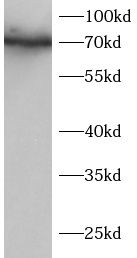Products
IRAK1 antibody
Category:
- SPECIFICATIONS
- Product Name
- IRAK1 antibody
- Catalogue No.
- FNab10246
- Size
- 100μg
- Form
- liquid
- Purification
- Immunogen affinity purified
- Purity
- ≥95% as determined by SDS-PAGE
- Clonality
- polyclonal
- Isotype
- IgG
- Storage
- PBS with 0.02% sodium azide and 50% glycerol pH 7.3, -20℃ for 12 months(Avoid repeated freeze / thaw cycles.)
Immunogen
- Immunogen
- interleukin-1 receptor-associated kinase 1
- Alternative Names
- IRAK antibody, IRAK 1 antibody, IRAK1 antibody, pelle antibody
- UniProt ID
- P51617
- Observed MW
- 70 kDa
Application
- Tested Applications
- ELISA, IHC, WB
- Recommended dilution
- WB: 1:500-1:2000;IHC: 1:50-1:500
Validated Images
 Jurkat cells were subjected to SDS PAGE followed by western blot with FNab10246(IRAK1 antibody) at dilution of 1:1000
Jurkat cells were subjected to SDS PAGE followed by western blot with FNab10246(IRAK1 antibody) at dilution of 1:1000
 Immunohistochemistry of paraffin-embedded rat kidney tissue slide using FNab10246(IRAK1 Antibody) at dilution of 1:50
Immunohistochemistry of paraffin-embedded rat kidney tissue slide using FNab10246(IRAK1 Antibody) at dilution of 1:50
- Background
- Serine/threonine-protein kinase that plays a critical role in initiating innate immune response against foreign pathogens. Involved in Toll-like receptor(TLR) and IL-1R signaling pathways. Is rapidly recruited by MYD88 to the receptor-signaling complex upon TLR activation. Association with MYD88 leads to IRAK1 phosphorylation by IRAK4 and subsequent autophosphorylation and kinase activation. Phosphorylates E3 ubiquitin ligases Pellino proteins(PELI1, PELI2 and PELI3) to promote pellino-mediated polyubiquitination of IRAK1. Then, the ubiquitin-binding domain of IKBKG/NEMO binds to polyubiquitinated IRAK1 bringing together the IRAK1-MAP3K7/TAK1-TRAF6 complex and the NEMO-IKKA-IKKB complex. In turn, MAP3K7/TAK1 activates IKKs(CHUK/IKKA and IKBKB/IKKB) leading to NF-kappa-B nuclear translocation and activation. Alternatively, phosphorylates TIRAP to promote its ubiquitination and subsequent degradation. Phosphorylates the interferon regulatory factor 7(IRF7) to induce its activation and translocation to the nucleus, resulting in transcriptional activation of type I IFN genes, which drive the cell in an antiviral state. When sumoylated, translocates to the nucleus and phosphorylates STAT3.



